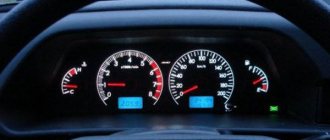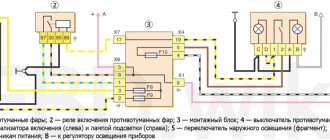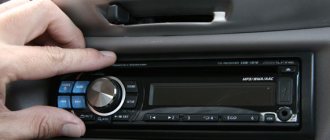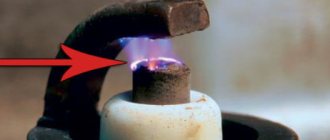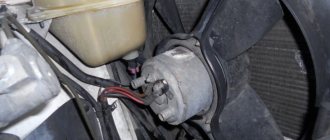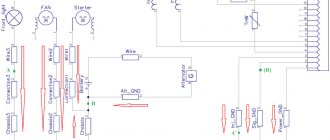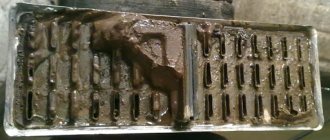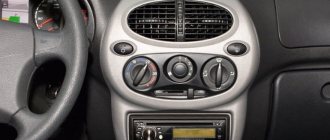The vehicle's electrical network is connected to a common “minus”, or mass, which is the entire body. That is, the body as a mass on the VAZ 2114 represents a single source of negative charge. And the source of negative charge is the connection between the case and the negative terminal of the battery.
If the wires connected from the electrical network to ground oxidize (come off), problems arise with the electronics, engine or control system. In case of typical “mass” faults, for example, “blinking” of the rear lights instead of turning on the turn signal or poor cranking of the starter, first check the condition of the wires connected to ground and contact points.
Weight of VAZ 2114
Why did it happen so?
Perhaps the automatic requests do not belong to you, but to another user accessing the network from the same IP address as you. You need to enter the characters into the form once, after which we will remember you and be able to distinguish you from other users exiting from this IP. In this case, the page with the captcha will not bother you for quite a long time.
You may have add-ons installed in your browser that can make automatic search requests. In this case, we recommend that you disable them.
It is also possible that your computer is infected with a virus program that is using it to collect information. Maybe you should check your system for viruses.
If you have any problems or would like our support team, please use the feedback form.
CarFrance.ru » Lada » 2114 » Electrics » Where is the mass from the engine to the body on the VAZ-2114: exact photos of the location
What to do if the battery is dead
Sometimes it happens that it is simply impossible to replace the battery in time. The way out of this situation is:
- using a starter charger;
- connecting to the on-board network of another vehicle (“lighting up”);
- An attempt to start with a pusher - the car with the ignition on is pushed and then the gear is engaged.
You need to remember: trying to start the engine with a very discharged battery can cause its breakdown or complete failure. A discharge of up to 60% (when the voltage at the terminals is less than 11 V) can cause serious trouble. One full discharge reduces the battery life by at least 25%.
Buying a battery for a Lada VAZ 2110 car is not difficult. You just need to choose the correct polarity, overall dimensions and other parameters of the battery. This will allow you to easily operate the vehicle.
Where is the mass from the engine to the body on the VAZ-2114: exact photos of the location
Experienced car enthusiast. I have an automotive education, namely: an engine repair mechanic. At the beginning of my career there was a VAZ-2107, then a BMW 5-series, a Toyota Supra and a right-hand drive MARK-2. Now the family has 2 cars: Peugeot 407 and Dodge Challenger 2016. I study each car from “A” to “Z”. I have a lot of experience and try to repair everything with my own hands.
The cost of a battery for a VAZ 2110
The price of a VAZ 2110 battery depends on a number of factors:
- manufacturer;
- starting current;
- containers;
- polarity.
According to customer reviews, the following batteries perform best:
| Name | Name Capacity, Ah | Starting current, A | Cost, rubles |
| Autofan | 60 | 470 | From 2 600 |
| Kainar | 60 | 540 | From 4 170 |
| Price Euro | 60 | 525 | From 4 900 |
| Mutlu | 63 | 550 | From 4 900 |
VAZ It’s all the fault of the “mass”
2110 2111 2112 Arrows jump on the instrument panel, the dashboard does not work
The situation looked like this: the engine is running, the engine is heating up, and the moment the cooling fan turns on, the arrow indicating the engine temperature jumps an order of magnitude higher. The car owner tried to change the engine temperature sensor, which takes readings for the instrument panel! Please note there are two of them, one for the shield and the other for the engine control unit. So the replacement did not lead to anything, everything remained as it was.
In the photo the arrow indicates the sensor that works for the instrument panel
My searches led me to the conclusion that this car is one continuous “bad mass.” I tried for a long time to determine the weak point, there was some kind of voltage loss at each contact, in the end everything worked fine only when I freaked out and attached the crocodiles for lighting, one to the other engine into the cabin to ground only after such a maneuver did the differences balance out and the sensor readings stopped jumping with the appearance of load.
I got out of the situation by throwing an additional wire that connected the ground of the engine and the sensors on the instrument panel. The mass on the instrument panel is screwed behind the socket near the driver’s right foot.
This is also a sore spot, often it unscrews and the instrument panel does not work at all!
Without departing from the topic, I had a case when the interior air blower in a car did not work, the reason also turned out to be a mass, only that mass was located near the mounting block and on the left side under the inner trim
So, if you have similar symptoms, I recommend checking the weight of your car first, given that this is a very common problem with these cars.
Author: Admin base-ex.com
Post navigation
How to replace terminals on all VAZ cars?
Removal: 1. Let's start with the fact that all the terminals are made differently and they hold the wires in different ways, some in the middle part clamp the wire, and some in the side, some terminals are connected to not even one, but two or even three wires (You can see a striking example in the photo below), after you look at your terminals and understand how many wires they hold, proceed to disconnect all the wires from the terminals, the side wires are easily disconnected, just unscrew the bolts that hold them and after that removed the wires from the terminal (Bolts are indicated by red arrows), but the middle wire (the largest) is the hardest to disconnect from the terminal and there are two options, either saw it at the root (as close as possible to the terminal, in the place indicated by the blue arrow), or cut the middle part that holds the wire (see small photo), in the first case you must take into account the fact that by cutting the wire it will become shorter and therefore immediately try on whether the terminal will reach the battery terminal after it is combined with this wiring, The second option is the best, but only for it you will need additional ones. tools, because you won’t be able to cut the metal with just anything (As a last resort, try using a hammer and a large flat screwdriver; if the metal is old, it will break it and the wire will be removed, but you will only have to remove the wire completely so as not to damage the car when you hit you will hit a screwdriver with a hammer).
Weight of VAZ 2114
Unreliable weight on the VAZ 2114 or its absence leads to various unpleasant surprises. For example, instead of a turn signal in the rear light, the lights suddenly start blinking (the so-called Christmas tree), or the starter barely turns. If you know where the masses of the VAZ 2114 are located, you can cope with many troubles in the electrical part of the car.
Location of common (mass) wires
The main ground wire is short and thick - it comes from the battery and is attached to a stud with a nut in the area of the front left side member. Its thickness is about 14-16 mm. Also, from the negative terminal of the battery there is a thin wire, which serves as a power supply to various energy consumers. Weak contact at the terminal leads to rapid discharge of the battery.
The electronic engine control system also requires a common wire. The mass of the VAZ 2114 ECU can be mounted in two different places depending on the modification of the car:
- On versions 2115 with a 1.5 liter engine, it is taken from the engine (two M6 bolts on the rear camshaft plug).
- On 1.6 liter internal combustion engines, as well as 1.5 liter engines with a Bosch or “January” version 7.2 ECU, it is fixed with a bolt screwed to the metal frame of the center console under the dashboard.
If the common wire of the electronics does not make good contact with the car body, then the ECM of the VAZ 2114 may cause various malfunctions.
Please note that the wire must be well secured
Where is the mass of the VAZ 2114 instrument panel located? There is only one common mass point in the cabin for the instrument panel wiring, luggage compartment wiring harness and fuse box circuit (models 2108-09 and 2113-2114-2115), it is located under the instrument cluster near the steering column.
The heater motor also requires a minus. It is attached to the heater body on the driver's side of the cabin.
The question remains - where is the mass of the VAZ 2114 engine. The mass is precisely the place where the main negative terminal of the battery is attached to the body.
How to find the location of a mass
Battery As a minus, a car battery has two conductors: one thin, the other thick. The role of the thick wire is to secure the ground in the VAZ 2114 from the battery negative to the motor housing. A faulty contact in this area leads to a decrease in charge transfer from the battery, a drop in starter power, and ECM problems.
To make sure that the ground is properly connected to the engine, you need to inspect the two fastening nuts that secure the contact to the engine body. To do this, slightly loosen the outer nut and tighten the inner nut, after which we apply additional tension to the outer one. The role of the thin wire is to connect the battery to the area of the car body in close proximity to the battery. This conductor is a single source for all electrical appliances in the car. The process of checking contact is also carried out by tightening the nut near the terminal and near the body. ECM Power for the control system is supplied from the engine housing, namely from the plugs located on the right side of the head block. Answering the question, where is the mass of the VAZ 2110 engine, which is equipped with a new generation ECM, the mass is taken from the stud attached to the dashboard frame. Sometimes it happens that the pin is not tightened too securely and eventually becomes loose.
Instrument panel The connection in this case is located in the area of the torpedo harness, combined with the mounting relay block and fuse system. It is located under the steering shaft mount. Malfunctions of this connection can lead to incorrect instrument readings during operation of large energy consumers, for example, headlights.
Heating motor The connected mass of the heating motor is located under the instrument panel, on the left side of the body. The main reason for the loss of conductivity properties by contacts is the fact that their surfaces are not treated in any way by the manufacturer, in addition to applying a layer of paint.
Additional ground wires
If the weight of the engine with the body is bad, then problems arise:
- The battery may not charge well;
- The starter turns poorly when starting the engine, or may not turn at all, only the solenoid relay will click;
- At full power consumption (high beam headlights on, heater motor running, etc.), the generator may not be charging enough.
When symptoms of poor engine weight appear, there is a way out of the unpleasant situation - in this case, additional weight on the engine will help. You can install an additional wire in different ways, the most important thing is that it reliably connects the car body with the power unit. For example, one end of the wire can be attached to the stud of the upper shock absorber support, and the other to the stud of the intake manifold of the internal combustion engine. It is important that the wire has a large cross-section, preferably no less than that of the bulk itself.
On new machines, problems with mass wires rarely occur. But on older models, the body studs rust. Finding a lack of ground is not so easy, so car owners use the installation of additional wires. So the additional mass on the generator helps eliminate battery charging leakage.
An additional wire is a necessity on used cars
Poor weight causes unstable engine operation. For example, a weak mass with the ECU affects the stability of the engine at idle speed. There is a loss of voltage in the circuit, and when the electric engine cooling fan is turned on, the idle speed drops noticeably, sometimes even to the point of stopping the internal combustion engine. Therefore, contact must be established and a reliable ground must be established. The problem on the new generation VAZ 2113-15 is also solved by installing an additional thick bulk wire (about 2.5 mm²) - it stretches from the negative terminal of the battery to the metal base of the center console in the car interior
Unreliable contact of the common wire of the instrument panel can affect the readings of sensors installed on the combination. In particular, when the dimensions are turned on, the arrows of the fuel level and coolant temperature indicators may deviate. It also happens that the instrument cluster is dimly lit. Behind the instrument panel itself there is a standard bolt for securing the ground; perhaps the fastening has become loose. You need to remove the shield and tighten the bolt.
Installing an additional wire from the negative of the cigarette lighter to the metal frame of the center console sometimes also solves the problem, and the instruments begin to display correctly.
Good day everyone, Friends and just Guests! Maybe the topic is not new, but still, sooner or later we all face this problem. I kept thinking for a long time about the point of installing additional mass? Let me remind you a little how it all started and why it made me think about installing additional weight on the car body
Then I saw a post by viktor53rus
New additional mass that he installed additional mass
And then I thought about it a little, why not put additional weight on the body, start small, if this doesn’t help then we’ll look for the reason elsewhere
Almost 100%, you can even say 200% - on modern cars, the body is used as a single source of electricity. The car body is like a universal wire with a negative charge for all consumers of electricity. That is why the body is called the painfully familiar term “mass.” And why “painfully familiar”? Yes, because if somewhere the contact with the ground is either poorly secured or oxidized, after the first measurement I began to look for the reason, I started with the simplest where the weak “mass” places are on the VAZ 2114 2113 2115 with 1.5 liter engines. I’ll try to describe the places in which are most likely to result in the loss of a reliable connection to ground, and the glitches that appear in this case. This is the mass of the battery.
The “minus” on the battery has two branches: a thick wire and a thin one. A thick wire runs from the battery negative to the engine housing. If this contact is not secured properly, then the battery is not fully charged, the starter does not develop full power, and the ECM stalls (because it takes weight from the engine)
On the negative mount of the battery with the engine, you need to check the tightness of the two nuts between which the contact to the engine is attached: first of all, loosen the outer nut and tighten the inner one, and then tighten the outer one. The second wire from the battery is much thinner and is attached to the body next to the battery itself. This wire is the source for all energy consumers in the car. Here you also need to check the tightening torque of the nut both to the body and to the battery terminal. Look at this whole thing and if there is oxidation, then you need to clean it down to white metal and screw the whole thing back. Then we go to look further where the mass is attached. ECM mass in Samar 1.5 l engine, the mass for the ECM is taken from the engine housing, from the fastening of the plugs. The plugs are located on the right side of the block head
View from above
Number 1 is the ground where the ECM wires are attached, and Number 2 is where the engine ground is attached.
In practice, it happens that this pin No. 1 is painted at the factory and is loosely tightened. Therefore, over time it may become loose and at the moment the fan is turned on, there will be a drop in the voltage of the following sensors (which will lead to jumps in speed): DTOZH, TPS, MAF.
Solutions to the problem
If power outages occur frequently or current leakage occurs during long periods of parking, you can improve the system to solve the problem. It’s not difficult to get the job done; the minimum set of tools that every motorist should have is enough. The procedure depends on the nature of the malfunction.
How to make mass better
If removing and cleaning the contacts does not produce any effect, you will have to use more radical repair methods. In some models, the problem with a minus on the body is a real “disease”, so it is necessary to improve the design in order to eliminate the manufacturer’s shortcomings:
- Replacing the wire. Most often this concerns the “braid” from the battery to the engine, since over time it becomes damaged or becomes heavily oxidized. It may also be necessary to install a core on the body with a large cross-section or the same one if it is damaged inside and does not pass current as necessary.
- Changing the mounting location on the body. Sometimes the stud for the nut literally bends out or the factory connection point does not make good contact. In this case, the easiest way is to find another place and secure the terminal there.
- Adding additional mass. Another option that will improve the system without much modification. Particularly well suited for older models and cars in which it is very difficult to get to the standard mount.
It is necessary to monitor the condition of the wires and replace them if there is even the slightest doubt about reliability. It is best to use the same elements as those installed, plus high-quality fasteners.
Installing the mains switch
The switch will protect the car from current leakage, short circuit, and can also serve as an additional anti-theft system. It’s easy to install it yourself; most often, one of two options is used:
- Manual switch. Placed under the hood in a suitable place. A more convenient solution is a special version combined with the battery terminal. It should be located between the battery and the ground wires of the engine and body.
- Remote option. In this case, the shutdown button is displayed in the interior; it is usually hidden so that no one else can start the car. The principle is the same, but installation is more complicated, since you need to run the wires into the interior.
The switch is not suitable for cars with an alarm and central locking, since if there is no ground, the system will not work. It is also undesirable to install it on models with a lot of electronics.
It is not difficult to locate the ground wires; they should be periodically removed and processed to ensure good contact. When checking, it is better to use a multimeter, this is the easiest way to detect damage if it is present. It is recommended to replace worn wires in a timely manner, and to prevent leaks, you can install a power switch button.
Power supplies
On the vast majority of modern cars, the power source is a three-phase alternating current synchronous generator driven by the main engine; three-phase alternating current from the generator is supplied to the built-in three-phase rectifier and voltage regulator circuit - in modern cars the voltage regulator is built into the generator housing. A car battery is used to provide constant and continuous power to some consumers when the engine is not running, such as lighting, car radio, brake lights, anti-theft alarm, as well as to fully power all vehicle systems when the engine is started. After starting the engine, the battery is recharged from the generator, and then it works in a buffer with the generator, smoothing out voltage drops when connecting powerful consumers. The generator power of a modern middle-class passenger car ranges from about 900-1300 watts.
Older cars used DC generators that were larger and heavier than three-phase generators; To maintain a constant voltage, a relay regulator was used, consisting of three devices - a voltage regulator, a current limiter and a reverse current relay.
In a number of cases, on special-purpose vehicles, as well as on armored vehicles, an additional generator driven by a separate internal combustion engine (the so-called auxiliary power unit) is installed, which makes it possible to supply consumers with electricity regardless of the operation of the main engine.
These include: switches and switches, relays, fuses, connector blocks, distribution and switching boxes, as well as power units.
Description of battery operation
A battery is a device with the help of which electrical energy is obtained from chemical energy and vice versa, with the ability to accumulate and store charge. The main purpose is to provide power to the electrical equipment of an idle vehicle, as well as to start the engine using the starter. If the generator does not work or cannot cope with the load, the battery takes over its role. The generator does not allow the battery to discharge, as it is a source of recharging.
Based on the type of electrolyte, rechargeable batteries are divided into two large groups: alkaline and acidic; based on the material of the electrodes, they are divided into:
- lead;
- zinc with the addition of silver;
- nickel-cadmium;
- iron-nickel.
Lead-acid batteries are the most popular. The principle of operation of the battery is simple: thanks to chemical processes, an electric current is generated, which is necessary to start the engine. A running motor receives electricity from a generator. In this case, electrical energy is obtained from mechanical energy. The battery receives electricity from the generator and converts it into chemical energy, storing it for further use.
Each battery has two poles: negative and positive. When connecting to the electrical circuit of the car, you need to know exactly what the polarity of the battery on the VAZ 2110 is, otherwise the electrical equipment may burn out.
Electricity consumers
Vehicle systems, depending on model and configuration:
- ABS - anti-lock wheel system (anti-skid automatic braking)
- SRS - safety system (airbags, belt tensioners, etc.)
- EFI, ECM - electronic engine management systems
- Electronically controlled automatic transmission
- Trip computer
- and other
Lighting devices
Main article: Car lighting devices
Automotive lighting devices are divided into external and internal.
- External ones include headlights (with low and high beam), side lights, turn indicators (combined with hazard warning lights), brake lights, reversing lights, license plate lights, fog lights, contour lights, spotlights, and in some cases decorative lamps.
- Internal lamps include interior lighting lamps, engine compartment lamps, trunk lighting lamps, glove box lighting lamps, instrument panel lighting lamps, etc.
Other consumers
- Starter
- Ignition system
- On-board computer
- Electric power steering
- Fan motors, windshield wiper drives, power windows, etc.
- Heated glass
- Parking sensors (parking sensors)
- Reversing cameras
- Seat servos
- Cigarette lighter
- Radio (radio), TV, multimedia entertainment system
- Sound signal
- Anti-theft alarm
- GPS navigator, built-in or separate,
- Seat heaters,
- as well as other auxiliary and information systems and devices.
Some types of household appliances, also adapted for use in a car, can receive power from the car's electrical network (connection is made either through a special socket or through the cigarette lighter socket). For this purpose, various adapters are used - from the simplest voltage dividers to switching power supplies with double current conversion. But the cigarette lighter socket was not initially designed to connect consumers other than the heating element of the “electric lighter”, so blown fuses and thermal damage to the socket are common (it is necessary to calculate the permissible current consumption based on the cigarette lighter fuses).
All ground mounting points for the VAZ of the tenth family
| If the electrics in the car start to malfunction, then one of the reasons for this ailment may be poor fastening of the battery mass. Ten have features of mass fastenings depending on the engine and year of manufacture of the car. We check all the attachment points of the negative wire: |
Location of masses in the car interior
| 1 - fuse block.2 - near the driver’s right foot there is a shield, which is attached with a couple of screws, removing it, you will see that everything is like in the picture.3 - in principle, the situation is similar to the point described above, except that the shield is located next to with the left leg of the navigator. |
| The stud in the dashboard behind the mounting block, in order to find it, you need to bend in a certain way. The headlight hydraulic corrector is shown there for reference; the ground pin is located above and to the left of it. Through this mass, the windshield wipers, heater fan (21124) and door lock activators are powered. |
| The console is on the right side, from here it is more convenient to check the very important ground pin, through which the bracket under the ECU is connected to the car body, and accordingly the reliability of the ground of the ECM and the cooling fan depends - this nut also holds the corner that supports the far part of the left panel of the console. |
| ECM harness mass crimps in the console. The connector was removed from the ECU and pulled out onto the driver’s mat, it’s more convenient. I bit the fan ground wire out of the ignition circuit crimp (left in the photo), extended it, put the tip on and connected it separately to the bracket. I soldered all connections for reliability. |
| Weight of the Electric Fuel Pump (EFP) module and fuel level indicator. A black and white wire is attached to the left rear handbrake lever mounting bolt under the floor tunnel. The fuel pump is powered through this mass, and the accuracy of the fuel level reading also depends on it. |
| The ground is on the stud of the fuel pump flange; this wire most likely connects the pump housing to the fuel filter bracket and this was done for safety reasons to equalize the potentials of these two devices. |
It is easy to find the ground of the electric fuel pump module without removing the tunnel; just fold back the mat, slightly bend or carefully trim the carpet of the floor behind the driver's seat below the ashtray of the rear passengers, without damaging the ground wire itself. Then the carpet easily falls into place and the cut is almost invisible.
Location of masses under the hood of a car
The battery terminal is large and thick with a large cross-section wire (approximately 16 sq. mm). Its thick part, about the thickness of a little finger, connects the negative battery and the engine. If the contact of this wire is unreliable, there may be a deterioration in the battery charge, a decrease in the starter rotation speed when starting, as well as problems in the ECM system, because the minus comes from the engine, from the studs on which the ignition distributor hung on carburetor cars.
| The thin wire connecting the minus battery and the car body is the main connection for all electricity consumers in the car, and in carburetor modifications also for the engine. Through this connection, all the car's lighting equipment, radio and other devices are powered, depending on the year of manufacture of the car. |
| The connection point for the negative terminal of the battery to the engine block is connected to the upper stud of the thermostat, if you look behind the air filter. The cross-section of the wire was chosen based on the large current consumption of the starter; this wire can easily be traced by hand if it is led from the battery. The starter current flows through this wire, charging the battery, some sensors screwed into the engine block are connected through it |
| Nearby there is another ground connection point to the engine block, it is slightly higher and to the left. The 2112 engine has two brown wires connected to this place - this is the mass of the ECM, that is, the mass of the sensors, ignition module, ECU and cooling fan. The arrow below shows the engine (starter) ground wire from the battery. |
| The mass point under the adsorber - Miha [email protected] suggested that this is the mass of the right headlight and the mass of the right fog lamp. |
How to improve the mass of the VAZ ECM
| If you notice that the engine speed fluctuates when the radiator fan is turned on, a possible reason is insufficiently reliable contact of the ECM ground with the vehicle ground. This is a known problem with the VAZ 2110 and VAZ 2113-2115 of the “new” model, in which the fan is controlled via a ground wire. We find out how to modify the weight of the car. |
Tests were carried out on a VAZ 21114, 2005 onwards, with a mileage of 7500 km, 8kl, 1.6l. Problem: When the car engine is warmed up, and the TPS position is 1-2%%, then at idle there is a noticeable (100-200 rpm) ) speed drift when the electric cooling fan turns on. At this moment, the voltage at the TPS output changes from 0.41 (when the fan is off) to 0.57 V (when the fan is on). Solution to the problem: Lay additional ground with a thick double-insulated wire (cross-section 2.5 sq. mm.) from the negative terminal of the battery to the metal frame of the center console of the instrument panel. The terminals at both ends of the additional wire are crimped and soldered. On a metal frame, our wire is secured to the stud for fastening the ground wires of the ECM, along with other ground wires. The terminals on the standard ground wire, which is installed between the battery negative and the car body, were also soldered. As a result: The voltage at the TPS output when the fan was turned on began to change within 0.39-0.46V. The result can be improved if the masses are separated ECM. After such modification, the readings will become 0.37-0.39V. Related measurements: The voltage on the green, ground wire of the TPS before and after reconnection practically does not change (it was 0.056-0.215V, now it is 0.03-0.03V). Also, as the contact of the ECM controller with the vehicle ground improves, a tendency for the voltage at the TPS output to decrease when the throttle valve is closed is noted. In the VAZ 2108-2115 family of the “old” type, the fan can be controlled by switching + 12V, so this modification option is not possible for them applies. By the way, if the electrics are faulty, then the cause may be poor ground contact.
Video “Which battery to choose”
This video provides recommendations for choosing a battery (the author of the video is GrigoryFF)
Buying a new battery for a VAZ 2110 will not be difficult. If the light on the instrument panel is on, you need to measure the density of the battery and check the generator. A generator that doesn't hold a charge well can cause serious problems—the car simply won't start.
If, after charging the battery with a special device, the car does not start, the required voltage between the two terminals continues to be absent, then you need to think about buying a new battery. The acquisition process has its own nuances and subtleties. It is important that the battery meets the basic parameters. The most significant ones include the following:
ATTENTION! A completely simple way to reduce fuel consumption has been found! Don't believe me? An auto mechanic with 15 years of experience also didn’t believe it until he tried it. And now he saves 35,000 rubles a year on gasoline! Read more"
- capacity;
- starting current;
- overall size and polarity of the battery.
